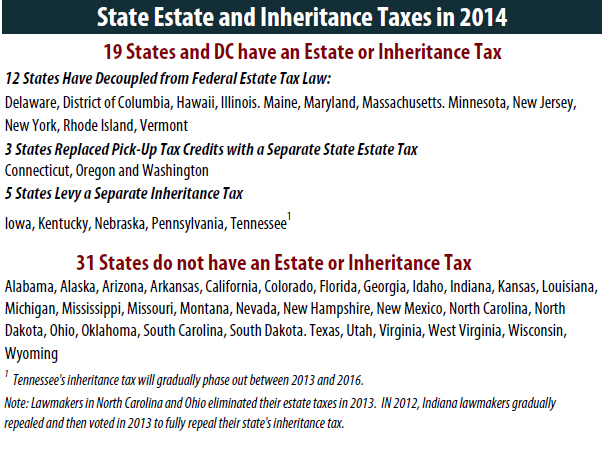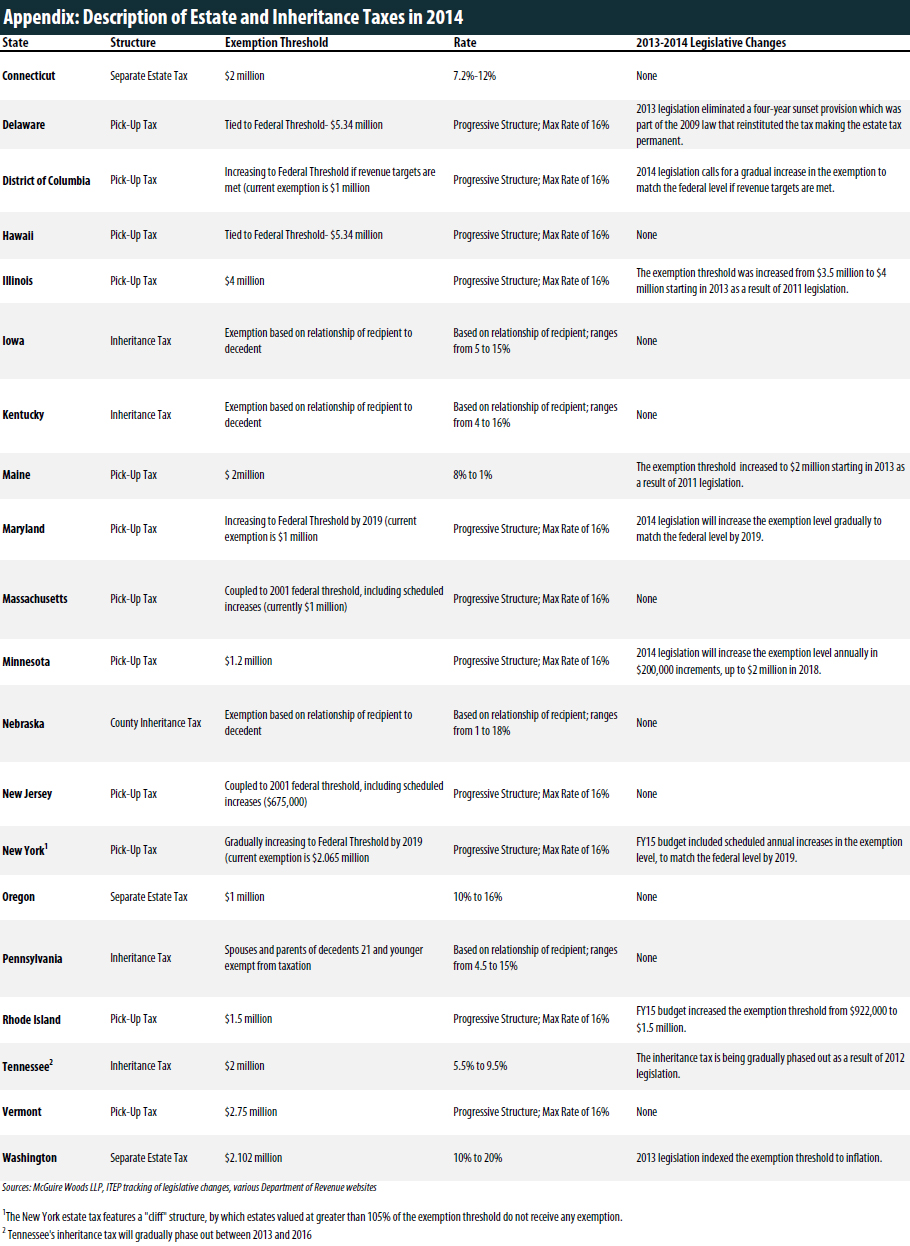Read this Policy Brief in PDF Form
 For much of the last century, estate and inheritance taxes have played an important role in helping states to adequately fund public services in a way that improves the progressivity of state tax systems. While many of the taxes levied by state and local governments fall most heavily on low-income families, only the very wealthy pay estate and inheritance taxes.
For much of the last century, estate and inheritance taxes have played an important role in helping states to adequately fund public services in a way that improves the progressivity of state tax systems. While many of the taxes levied by state and local governments fall most heavily on low-income families, only the very wealthy pay estate and inheritance taxes.
Recent changes in the federal estate tax, however, culminating in the “fiscal cliff ” deal of early 2013, have forced states to reevaluate the structure of their estate and inheritance taxes. Unfortunately, the trend of late has tended toward weakening or completely eliminating state estate taxes. This policy brief discusses inheritance and estate taxes and how states can adopt these important components of a progressive tax structure.
The Long History of Estate Taxes
Until 2001, levying a tax on the transfer of wealth from one generation to the next was one of the few things all fifty states could agree on. After the federal government enacted an estate tax in 1916 to “break up the swollen fortunes of the rich,” every state enacted a similar tax of its own. While these taxes typically represent only a small part of overall state tax collections, estate taxes (which are paid by taxable estates upon death) and inheritance taxes (which are paid by those individuals who receive gifts from estates) play an important role in reducing the transmission of concentrated wealth from one generation to the next. This function is now more important than ever: in 2010, the wealthiest 1 percent of Americans owned 35.4 percent of the wealth nationwide—more than the poorest 90 percent put together.
How the Federal Estate Tax Works
The federal estate tax was designed to apply only to the very wealthiest Americans—and that’s exactly what it does. In fact, the percentage of deaths in the U.S. resulting in federal estate tax liability hit a historic low of 0.15% for deaths occurring in 2011 and owing tax in 2012. (Estate taxes are usually filed during the year after the year in which a person dies.) This is largely the result of
a decade-long trend toward weakening the federal tax. After President George Bush’s 2001 tax cut package authorized the gradual repeal of the federal estate tax by 2010, President Barack Obama and Congress agreed in 2011 to reinstate the tax with a basic exemption of $5 million – the highest level ever – indexed to inflation. As part of the “fiscal cliff ” deal enacted in early 2013, the higher exemption level was made permanent.
The basic exemption exists to exclude low- and middle-income households from the estate tax, with only those estates valued at higher than the exemption level subject to tax. Today, the current steep exemption threshold of $5.34 million effectively exempts even many wealthy households from taxation. To illustrate, during the decade prior to the Bush tax cuts, the exemption level hovered within the $600,000 range and the percentage of estates subject to tax was as high as 3%. It should be noted that the “fiscal cliff ” deal also made the portability of the estate tax exemption for married couples permanent meaning that the 2014 exemption level for a married couple is $10.68 million.
For the few estates which do still breach the exemption threshold, the structure of the tax provides for multiple deductions that serve to lower the amount of the taxable estate (and therefore slash tax liability further), including funeral expenses, mortgages and other debts, bequests to surviving spouses, and charitable donations. Family farms and small businesses are also eligible for value reductions to ensure that they are not impacted by the tax. A tax rate of 40% is applied to the net value of the estate.
How State Estate Taxes Work
The same Bush-era legislation which diluted the federal estate tax also importantly impacted the traditional structure of state estate taxes, and continues to threaten their future. Since 1926, the federal estate tax allowed a dollar-for-dollar tax credit against the estate taxes levied by states, up to a certain maximum amount. The credit gave states an incentive to levy an estate tax at least as large as this credit: in the states levying a “pickup tax”—that is, a tax calculated to be exactly equal to the maximum federal tax credit—the state’s estate tax amounted only to a transfer of estate tax revenues from the federal government to the states. In other words, the pickup tax did not change the amount of estate tax paid—it just meant that part of the federal estate tax liability was being shared with, or “picked up” by, state governments.
Every state took advantage of this incentive to enact an estate tax at least as big as the pickup tax until 2001 the Bust tax cuts phased out the federal credit. In many of the states that base their tax on the federal credit, this meant that the state’s estate tax also ceased to exist in 2005. The “pickup tax” credit was scheduled to come back to life along with the federal estate tax in 2011, but Congress instead extended the repeal of the credit and replaced it with a deduction for two years. As a result of the fiscal cliff deal struck in late 2012, the credit was permanently eliminated and replaced with the deduction.
In the aftermath of the pickup tax credit’s repeal in 2005, many states took steps to prevent the complete elimination of their estate tax. This happened in two ways: some states “decoupled” from the federal estate tax cut, effectively tying their own estate tax to the pickup tax credit as it existed in 2001 prior to the repeal, while other states instituted their own separate estate or inheritance taxes. Many states which decoupled from the cut still continued to couple to the exemption levels set by the federal law; others created their own exemption thresholds.
Among the states that have decoupled from the pickup tax credit elimination but still allow the same exemption levels used in the federal tax are Delaware and Hawaii. D.C., Maryland, and New York recently enacted legislation to gradually raise their exemption thresholds to match the federal level. States decoupling from the pickup tax credit elimination and maintaining their own exemption thresholds are Illinois, Maine, Massachusetts, Minnesota, New Jersey, Rhode Island, and Vermont, some of whom, such as New Jersey, have maintained the $675,000 exemption threshold in effect prior to the Bush tax cuts. Connecticut, Iowa, Kentucky, Nebraska, Oregon, Pennsylvania, and Washington all maintained their own separate estate or inheritance taxes following the elimination of the pickup credit (See the Appendix for details on state estate and inheritance taxes).
Options for Reforming State Estate Taxes
The 31 states still lacking an estate tax as a result of the pickup tax credit elimination have an easy way of introducing this source of progressivity back into their tax structures: decoupling from the federal tax repeal. Using New Jersey, Massachusetts, and Maine (among others) as models, states could achieve this by defining the state estate tax to equal the federal credit as it existed in 2001—before the passage of the Bush administration’s estate tax cuts. States taking this step will effectively have a tax with a rate of 16 percent on estate value in excess of the federal exemption amount (which is $5.34 million in 2014). States taking this step can also “piggyback” on special federal provisions that help to ensure that small businesses and family farms won’t be hit by the estate tax, including a provision assessing farmland according to its agricultural value, not its market value, an extra exemption for family-owned businesses above the basic amount, and a provision allowing certain estates to pay the estate tax over 14 years.
Unfortunately, many states have gone the opposite way in the recent past. North Carolina and Ohio both eliminated their estate taxes effective in 2013, with Indiana also eliminating its inheritance tax. Indiana Governor Mike Pence initially signed a bill in 2012 authorizing the repeal of the tax over 9 years, but the state fast-tracked the plan last year with an immediate repeal. Legislation passed in 2012 in Tennessee will phase out that state’s inheritance tax by 2016. Lawmakers in D.C., Illinois, Maine, Maryland, Minnesota, New York, and Rhode Island either increased their exemption thresholds in the past year or passed legislation calling for future increases, to be achieved by gradually coupling their exemption levels to the federal threshold or through independent legislation. (See Appendix for information on recent legislative changes) On a more promising note, Delaware took steps to preserve its estate tax in 2013 through legislation eliminating a 4-year sunset provision included in a 2009 bill which decoupled the state’s tax from the federal pickup tax credit elimination.
Inheritance Taxes
Despite often being confused with estate taxes, inheritance taxes are slightly different mechanisms for taxing the transfer of wealth after a death. Inheritance taxes are paid not by the estate of the deceased, but by the inheritors of the estate. For example, the Kentucky inheritance tax “is a tax on the right to receive property from a decedent’s estate; both tax and exemptions are based on the relationship of the beneficiary to the decedent.” In Kentucky there are three classes of beneficiaries. If the beneficiaries of the estate are a parent, child, sibling, or grandchild or other close relation no inheritance tax is due. Nieces, nephews, aunts and other specific relations receive a $1,000 exemption and pay tax rates of 4 to 16 percent on their inheritance. Other classes of beneficiaries receive a $500 exemption and must apply tax rates between 6 and 16 percent to their gift.
Final Word
Estate and inheritance taxes can help to make state tax systems less regressive. And, while these taxes typically represent only a small part of overall state tax collections, they play an important role in reducing the transmission of concentrated wealth from one generation to the next. This makes the recent trend toward cutting state estate taxes especially troubling. Because the federal estate tax has weakened over the last decade, states have an opportunity to lead on this important issue and develop or even strengthen their estate and inheritance taxes.






